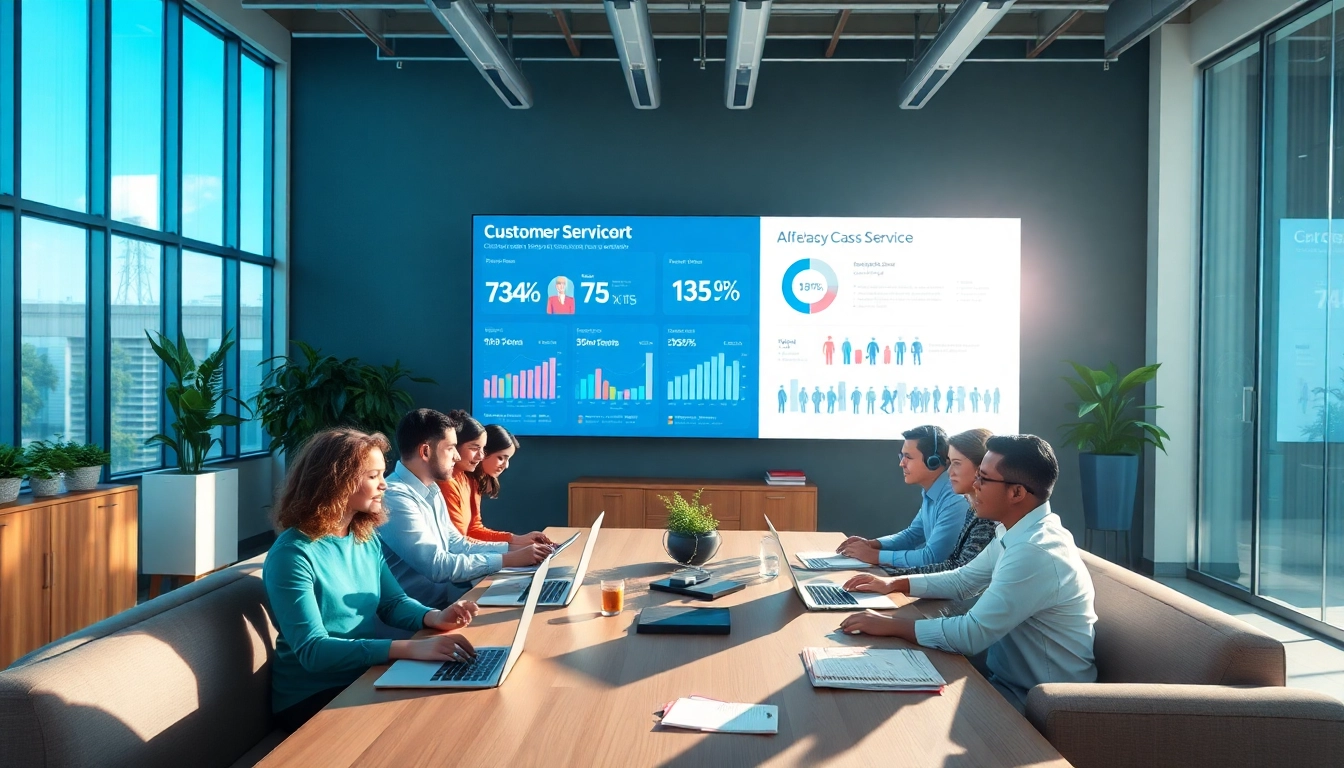
Understanding Helpdesk Support
What Is Helpdesk Support?
Helpdesk support is a crucial service provided by companies to assist customers and employees with their inquiries, technical issues, and specific needs related to products and services. A helpdesk acts as a centralized hub where users can report issues, seek advice, and receive solutions from trained support personnel or automated systems. The service often includes managing requests via tickets, which track the progress of customer inquiries and technical problems until they are resolved. By streamlining this process, helpdesk support enhances customer satisfaction and operational efficiency, allowing companies to respond quickly to issues that may arise.
The Importance of Helpdesk Support in Businesses
In the modern business landscape, effective helpdesk support is more important than ever. It serves not only to resolve problems but also to build customer loyalty and trust. With the increasing reliance on technology, companies must ensure that customers receive timely assistance. Helpdesk support contributes significantly to customer experience by reducing wait times and providing efficient solutions, ultimately fostering a positive brand image. Moreover, it allows businesses to collect valuable feedback from users, which can guide improvements to products and services.
Different Types of Helpdesk Services
Helpdesk services can be categorized into several types based on their focus and delivery method:
- Technical Support Helpdesk: Primarily focused on troubleshooting and resolving technical problems, this type serves users who have specific issues with software or hardware.
- Customer Support Helpdesk: Aimed at assisting customers with general inquiries, this service focuses on providing information about products and services, guiding users through their use.
- IT Helpdesk: This service is tailored for internal users, focusing on IT issues within an organization, including network outages, application errors, and system updates.
- Remote Support Helpdesk: Leveraging technology, remote support can resolve issues via screen sharing or remote access tools, allowing support staff to troubleshoot problems without needing to be physically present.
Common Challenges in Helpdesk Support
Identifying Frequent Issues Faced by Support Teams
Helpdesk teams frequently encounter a variety of challenges that can hinder effective service delivery. Common issues include:
- High Ticket Volume: As user reliance on technology increases, helpdesk teams often experience overwhelming ticket volumes, making it challenging to respond promptly.
- Information Silos: When customer inquiries are not logged or shared correctly, valuable insights can be lost, leading to repeated issues that might have been resolved earlier.
- Employee Turnover: High turnover rates among helpdesk staff can lead to inconsistency in service delivery and knowledge gaps, affecting the quality of support provided.
Barriers to Effective Customer Communication
Effective communication is vital for successful helpdesk interactions. Barriers may include:
- Language Differences: In multilingual environments, misunderstanding due to language barriers can lead to frustration for both customers and support staff.
- Technical Jargon: Using overly complex technical language can alienate customers and hinder their ability to convey issues accurately.
- Insufficient Follow-Up: Lack of timely updates on ticket status can create dissatisfaction and frustration among customers, making them feel overlooked.
Strategies to Overcome Helpdesk Support Challenges
Addressing the aforementioned challenges requires a proactive approach. Effective strategies include:
- Investing in Helpdesk Software: Implementing advanced ticketing systems can automate many support processes, improving response times and helping teams manage ticket loads effectively.
- Regular Training Sessions: Providing ongoing training for helpdesk staff ensures they stay updated on technical knowledge and customer service best practices.
- Enhanced Communication Tools: Equipping support teams with tools that facilitate clear communication can help to mitigate misunderstandings and improve customer interactions.
Best Practices for Helpdesk Support Management
Implementing a Customer-Centric Service Model
A customer-centric approach is essential for effective helpdesk support. This requires:
- Mapping Customer Journeys: Understanding the customer experience from their perspective helps identify critical touchpoints that require support intervention.
- Soliciting Regular Feedback: Actively asking for customer feedback and incorporating it into service improvements fosters a culture of customer care and continuous enhancement.
- Providing Self-Service Options: Empowering customers with access to self-service resources enables them to solve minor issues independently, relieving pressure on helpdesk teams.
Utilizing Helpdesk Software and Tools
Selecting the right software is pivotal for effective helpdesk management. Key features to consider include:
- Ticket Management: A robust system should allow priority settings, categorization, and tracking of requests throughout their lifecycle.
- Knowledge Base Integration: A searchable knowledge base equips customers with solutions for common issues, reducing overall ticket volume.
- Analytics and Reporting: Analytics capabilities provide insights into performance metrics, helping management evaluate support effectiveness and identify areas needing attention.
Measuring Helpdesk Performance Metrics
Tracking performance metrics is vital to gauge the effectiveness of helpdesk operations. Key performance indicators (KPIs) to monitor include:
- Response Time: The time taken for helpdesk staff to address a ticket is crucial for measuring service efficiency.
- Resolution Time: Monitoring how long it takes to resolve issues provides insights into the effectiveness of support processes.
- Customer Satisfaction Score (CSAT): Soliciting feedback post-resolution helps gauge user satisfaction levels and identifies opportunities for improvement.
Case Studies: Successful Helpdesk Support Implementations
Examples of Effective Helpdesk Support in Action
Numerous companies have successfully implemented helpdesk support strategies that improved customer experience markedly. For example:
Company X: By investing in a new helpdesk software, Company X reduced its average ticket resolution time from 48 to 12 hours, significantly increasing customer satisfaction ratings from 70% to 90%.
Company Y: After establishing a self-service knowledge base, Company Y saw a 30% decrease in ticket volume as customers learned to resolve common issues independently.
Lessons Learned from Helpdesk Support Failures
Failures can also yield valuable insights. A notable case is:
Company Z: After neglecting to provide adequate training for new staff, Company Z experienced a surge in unresolved tickets and a decline in customer satisfaction. The organization learned the importance of continuous training and support.
How to Adapt and Improve Helpdesk Strategies
Adaptation requires diligence to stay ahead of trends and changing customer expectations. Continuous improvement strategies can include:
- Regular Service Audits: Routine assessments help identify bottlenecks and areas for improvement within helpdesk operations.
- Feedback Incorporation: Using feedback from customers and staff to modify processes ensures that service evolves alongside user needs.
- Investing in Emerging Technologies: Staying informed about advancements in artificial intelligence and automation can help organizations to implement innovative tools that enhance support services.
Future Trends in Helpdesk Support
The Role of AI and Automation in Helpdesk Services
The integration of artificial intelligence (AI) and automation in helpdesk support is transforming the industry. AI-driven chatbots can handle tier-one inquiries, offering immediate assistance while freeing up human agents for more complex problems. Furthermore, machine learning algorithms can analyze historical data to predict common issues, allowing proactive measures to be taken. As technology advances, organizations must keep pace and strategically integrate these tools into their helpdesk operations.
Shifting Customer Expectations and Experience
Today’s customers expect swift and personalized service. This shift is driving helpdesk teams to adopt more agile methodologies, focusing on quick resolution and tailored interactions. Businesses need to prioritize enhancing the customer experience, ensuring that support is not just about solving problems but also about building meaningful relationships with users.
Preparing for the Next Generation of Helpdesk Support
Looking forward, organizations must prepare for the increasing complexity of support needs. This may involve expanding helpdesk capabilities to include omnichannel support, allowing users to reach out across multiple channels like social media, chat, or traditional phone calls, ensuring a seamless experience. Moreover, investing in continued staff training and fostering a culture of adaptability will be key drivers of success in the evolving landscape of helpdesk support.






